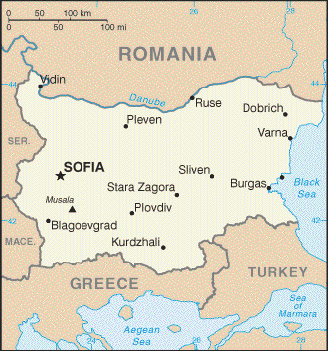Bulgaria
Travel The World

Country name: Bulgaria ( Balgariya) or Republic of Bulgaria ( Republika Balgariya)
Capital: Sofia
Location: Located in South Eastern Europe, Bulgaria is bordered by Greece and Turkey to the South, Romania to the
North and Macedonia and Serbia to the West. Its Eastern Border is formed by the beautiful Black Sea Coast.
Nationality: Bulgarian
Ethnic groups: Bulgarian, Turk, Roma, other - Macedonian, Armenian, Tatar, Circassian
Religions: Bulgarian Orthodox, Muslim, Christian, others
Languages: Bulgarian, Turkish, Roma, others.
Background:
As a state established by Khan Asparoukh, Bulgaria has been in existence for more than 13 centuries.
Thracians were the first settlers in the Bulgarian lands, and their civilisation is evidenced by numerous archaeological finds, tombs, gold and silver treasures.
Evidence of the presence of life in prehistoric times exists in the best preserved Neolithic dwellings discovered world-wide – namely those near the town of
Stara Zagora, in the Bacho Kiro cave near the town of Dryanovo, and in the Magurata cave, close to the town of Belogradchik.
The first written reference of the name “Bulgarians” is found in an anonymous Roman chronography of AD 452.
The history of Bulgaria is divided into four major periods: First Bulgarian kingdom (AD 681 – 1018); Second Bulgarian kingdom
(AD 1185 – 1396); Third Bulgarian kingdom (1878 – 1945), and Modern Bulgaria.



Images: From left to right. Green field in the Etara National Preservation near Gabrovo, front stone stairs of an old
desolate stock building in Balchik, near Varna, Balkan, view from the Monastery of Glojen.
Some Interesting Statistics:
111 The number of thousands of square kilometres of Bulgarian territory (making it half the size of the UK)
9 Thousand feet high – that’s Mount Musala, the highest point in the country (just under 3 thousand metres, as lofty as all but
the biggest Alps, and dwarfing Britain’s Ben Nevis (1,340 m).
Nine also represents the number of cities in Bulgaria with a population greater than 100,000 (Sofia, the capital, has a little
over a million residents).
40 The percentage of Bulgaria under the plough: it is very much a farming nation (compare Britain’s 23%)
7.5 Million people – that’s Bulgaria’s population: looking at it another way, Bulgaria has 68 people per square kilometre,
compared with Britain’s 250 – and the Bulgarian population is falling!
38 The number of British pence which equal one Bulgarian lev (so there are just under three leva to the pound).
It is also the percentage of Bulgaria’s land which is covered in forest
37 Thousands of kilometres of motorway, the same amount in both Britain and Bulgaria – and Bulgaria, remember, is half the size!
1,600 The number of natural hot springs in Bulgaria.
2 Bulgaria is two hours ahead of Greenwich meantime (three in summer).
15 Professional soccer clubs in Bulgaria’s premier division
512 The number of years that Bulgaria was ruled by the Turks (1396-1908).
4,000 The number of known caves in Bulgaria’s mountains: there are plenty waiting to be discovered.
4 The number of Bulgarian kings (in the modern era, anyhow): they started with Alexander in 1879, and ended with Simeon II in 1946 (he was deposed by
the Russians when he was ten years old, but lived on in exile, returning to Bulgaria to become prime minister of his country – he won the 2001 elections)
90 The number of days an EU citizen can spend in Bulgaria without requiring any visa or special travel documents.
10 Percentage of the Bulgarian population which is ethnically Turkish.
380 The number of kilometres (240 miles) of Black Sea coastline enjoyed by Bulgaria.
5 The countries which have land borders with Bulgaria: Rumania, Greece, Turkey, Serbia
Forming the heart of several of ancient histories greatest civilizations Bulgaria's rich culture is reflected in a vast number of architectural treasures.
Only Greece and Italy have a greater number of historical monuments. Throughout the country you will find ancient Greek sites, Roman amphitheatres
and Byzantine churches. The country is home to 160 monasteries, 36 cultural centres and 40,000 listed archaeological monuments.
Seven sites have achieved a coveted place on the UNESCO world heritage list.
There are 7 national parks, more than 3000 protected natural sites and 17 bio-spherical reserves (the greatest recorded
number in Europe). There are also 419 protected animal species and 63 protected types of plant.